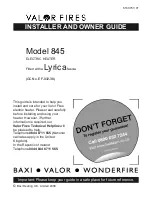
6 720 646 804
Installation instructions
13
of the relief valve, and possibly the heater itself.
Replacing the relief valve will not correct the problem!
The suggested method of controlling thermal expansion
is to install an expansion tank in the cold water line
between the water heater and the check valve. The
expansion tank is designed with an air cushion built in
that compresses as the system pressure increases,
thereby relieving the over-pressure condition and
eliminating the repeated operation of the relief valve.
Other methods of controlling thermal expansion are
also available. Contact your installing contractor, water
supplier or plumbing inspector for additional information
regarding this subject.
3.5
Electric requirements
Power requirements
Check the markings on the rating plate of the water
heater to be certain the power supply corresponds to
the water heater requirements.
Electrical connections
A separate branch circuit with copper conductors, over-
current protective device and suitable disconnecting
means must be provided by a qualified electrician.
All wiring must conform to local codes or latest edition
of National Electrical Code ANSI/NFPA 70.
The water heater is completely wired to the junction box
at the top of the water heater. An opening for ½” or ¾”
electrical fitting is provided for field wiring connections.
The voltage requirements and wattage load for the
water heater are specified on the rating label on the
front of the water heater.
The branch circuit wiring should include either:
• Metallic conduit or metallic sheathed cable approved
for use as a grounding conductor and installed with
fittings approved for the purpose.
• Non metallic sheathed cable, metallic conduit or
metallic sheathed cable not approved for use as a
ground conductor shall include a separate conductor
for grounding. It should be attached to the ground
terminals of the water heater and the electrical distri-
bution box.
Fig. 10 Water heater junction box
This water heater must be connected to the building
electrical system on a dedicated branch circuit. A
25amp circuit breaker must be installed for overcurrent
protection.
This water heater must be connected to the building's
electrical supply with 10AWG copper wire or larger.
If higher wattage elements are installed, consult the
National Electrical Code (NFPA 70) to determine the
proper circuit breaker and minimum wire size.
Caution: Do not mis-wire electrical
connections. 240V AC must be applied
to L1 and L2 wires as shown in Fig. 10.
Failure to do so will VOID the warranty.
Connecting the water heater to 120V
AC may damage the compressor or
other electrical components.
Warning: Proper ground connection
is essential. The presence of water in
the piping and water heater does not
provide sufficient conduction for a
ground. Use of non-metallic piping,
dielectric unions, flexible connectors,
etc., can cause the water heater to be
electrically isolated, which may cause
fire or shock.














































